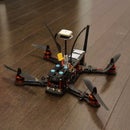Introduction: Lead Wrist Weights
Goku did it, and look how buff he is now!
I searched around for ages looking for an instructable on wrist and/or ankle training weighs, which I could wear during my everyday activities, and put some exercise into my otherwise fairly lazy life.
All the articles I came across, however, produced big chunky weights full of sand, or wheat, which could only really be used during actual training, without looking silly.
So I sought to make a pair of wrist weights which I could wear all the time, and look cool. Maybe even pick up (ok wishful thinking).
Read on...
Step 1: Theory
Sand and wheat are great, accessible, easy to work with materials, but at 1.6 and 0.6 grams per cubic centimetre respectively, I needed something more dense.
Lead (atomic number 82, chemical symbol Pb) is very heavy - about 11 grams per cubic centimetre, extremely soft and malleable, and has a melting temperature of only 327 degrees celsius. These characteristics all combine to form the perfect material for my purposes. My only other choice would have been Uranium, but that's a bit harder to obtain. And it causes cell mutation/super powers.
WARNING!
Lead is a heavy metal. It is poisonous if ingested or inhaled, causing nerve damage, blood and brain disorders. Make sure you wash your hands thoroughly after handling, and use proper ventilation during the melting process. Also wipe down the food preparation surfaces near the stove afterwards. If you have children, you may want to wash your clothes after working with lead, to avoid exposing them to any lead particulate on your clothes.
Step 2: Materials
What you will need:
- Lead. Luckily for me, my Mum does Lead-lighting as a hobby, and had tons (really!) of offcuts which I could use.
You could pick up offcuts and scraps from a lead-lighting shop, or fishing sinkers are good too. I don't know if fishing shops through out old ones, or something, but it's worth a shot (haha lead shot). Unfortunately this is one instructable where you can't find the materials at the tip, because tips won't accept heavy metals.
- A Mold. I Chiseled mine out of a block of wood.
- Toweling material. I cut up an old towel (duh!). And some velcro.
- An old pot with which no-one will EVER cook again. It is now quite poisonous.
note: The pot is in no danger of melting as aluminium melts at a temperature more than twice that of Lead.
Step 3: Measurements
I wanted the weights to be as uninhibiting as possible, and they are not comercial, so didn't need to be adjustable. Therefore I measured my wrists and made the weights to fit snuggly. 22 cm circumference for me.
Step 4: Make a Mould
or should I say "Cast". In metal forging, it's called a cast. Or is it a die? terminology aside, you'll need something to hold your molten lead.
In order to have as much weight in as little wristbands as possible, I needed to have them be solid lead. Not pouches filled with offcuts. So I chiseled a 22cm long ingot out of a block of pine, into which I would pour molten lead (it's not gunna catch fire at a mere 300 degrees).
At 11 grams per cubic centimetre, I calculated that 1 kilogram of lead would occupy 90 cubic centimetres, or 90 millilitres. I chiseled out what I thought looked about right, then tested it by pouring 100 mL of water from a measuring jug into the mould. It overflowed, so I carved out a little bit more.
Step 5: Alchemy
I measured out one kilo of offcuts into an aluminium pot which I bought from the op-shop. I then emptied it and beat a pouring spout into the pot, because people DO cry over spilt molten lead. I replaced the offcuts and bunged it on the cooker, setting high. Notice the fan next to the stove. High tech. All the windows and doors were open, because lead produces toxic gas when burned. After not too long at all, the lead began to melt, and I stirred it around with a wooden stick. It's a wierd situation to plunge a stick into liquid and pull it out all charred and glowing. Unfortunately the lead didn't transmute into gold, but I wasn't holding my hopes too high anyway.
I covered my mould in aluminium foil to make it easier to get the solid ingot out later on. Then, when there were no chunks left, I poured the molten lead into the mould.
Attachments
Step 6: Bending to Wrist-shape.
Step 7: Hinges
I drilled - very easily - some holes through the new semi-circles, and bound them together with galvanised wire.
Step 8: Outer Material
Now I had functioning wrist weights. And they looked damn cool. But they weren't very comfortable. So I measured out a pattern, cut up a towel, some velcro and some old curtain material (for strength) and sewed like the wind!
A tube with double thickness toweling on the inside half, and curtain material on the inside of the ouside half (understand?) to provide strength when I sewed on the velcro, and Voila! 2 X 1Kg wrist weights.

Participated in the
Fitness Challenge














